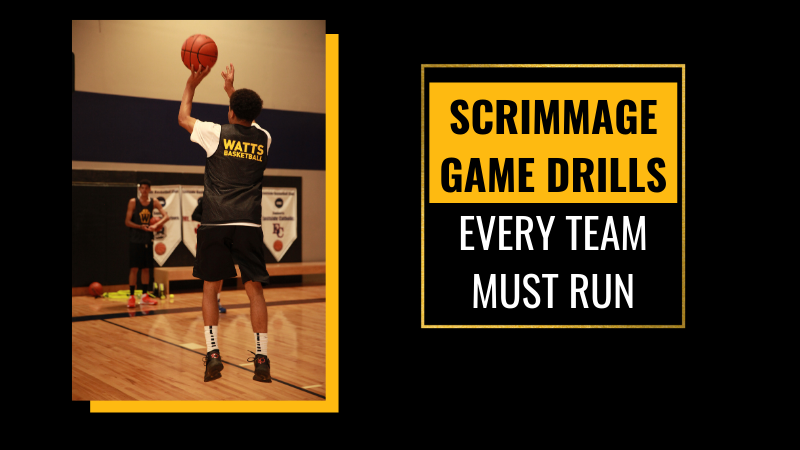When the off-season goes into full swing, competitive action may come few and far between. The reason being, official matches are nowhere to be found on the schedule, leaving every team no choice but to focus on skills development, playbook practices, and strength and conditioning workouts. Still, there is a way for squad members to engage in competition, and this comes in the form of a scrimmage game.
Now, what is a scrimmage? It is a customized basketball game played by two groups, which are often units of the same team. It serves as a battleground to nurture the competitive spirit of teammates, all while building chemistry and practicing plays that will be used in official outings. Now there are various ways to run a scrimmage game, and here are several of them.
Custom Match: Drills To Do In A Scrimmage Game
While a scrimmage game is a simulation of a normal basketball match, it can be modified to suit a certain playing style that a coach aims to put into practice. Each type also comes with unique rules that only come into effect during such controlled bouts. To get right into it, take a look at some of the most relied upon scrimmages out there.
Quick Strike Transition Scrimmage
The sport of basketball has evolved over time, and one of the most evident changes in game execution is how fast the pace goes nowadays. Simply put, the game is faster than ever. To keep up with the changing times, a team can develop a swift offensive thrust through the quick strike transition scrimmage game.
This drill makes full use of the Blitzkrieg strategy, an offensive warfare method that focuses on lightning-fast attacks to catch the defense by surprise. In basketball terms, it is about pouncing on the gaping holes of an opposing team that has yet to set its defense in place. Speed is the name of this game, and the team that lacks thereof will be left in the dust.
To get right into it, here is how it is run.
- Prepare two teams of five players.
- Set up a shot clock that only runs for 15 seconds per possession. As soon as there is a turnover or change in possession, the timer should reset. In case there is a lack of shot clock in practice, make sure a coach or an assistant has a watch on hand to count down the time.
- Impose a scoring system where a team gets awarded with points that correspond to the time left on the shot clock after scoring. For example, if a squad converts a basket in possession with six seconds left on the timer, they would earn six points.
- The side that ends up with the most points at the end of a set period of time comes out on top.
There are countless benefits of this scrimmage game to a team, one of which is to get accustomed to making decisions on the fly while finding scoring opportunities in transition. It also forces the players to adapt a defensive counter for high-octane offensive attacks, as well as build their stamina to endure the stop-and-go action on the floor.
No Dribble Scrimmage
To draw out the full potential of a team, the members should be more than willing to distribute the ball to one another on the court. In other words, the art of passing is the key to teamwork. And no scrimmage game puts a team’s ability to dish out passes to the test better than the no dribble drill.
This scrimmage game, as its name goes, is a drill that restricts players from dribbling the ball throughout the length of the court. This means that they should run an offensive charge that revolves around dishing out the ball to move towards the basket and score points in a bid to produce winning results. In depth, aside from passing, it enhances a team’s court vision, off-ball movements, offensive rotations, spacing on the floor, and ability to cut through open lanes. It also trains them to develop a set of defensive schemes to counter a pass-heavy offense.
The instructions to execute this scrimmage drill are simple.
- Divide the team into groups of five.
- Have a coach or an assistant that can officiate the game. The no dribble rule should be applied, along with other normal regulations.
- Set a time limit for the game, and whoever scores the most points at the end of regulation wins.
Crunch Time Scrimmage
There will always come a time that a team would have to perform in the clutch to defeat an opponent and eke out a victory. So, it is crucial for the players to immerse themselves in pressure-packed situations and get used to performing at a critical juncture of a match. This is where the crunch time scrimmage game proves to be beneficial.
This controlled scrimmage basketball drill draws out the capabilities of a team to execute game-winning plays under pressure and fatigue. It helps them develop game sense and collect experience of late-game scenarios, which can be translated into official games when a down-the-wire situation arises.
Here is a breakdown of how this scrimmage game drill works:
- Assemble two teams of five players.
- Start the score count at 75-all before initiating a jump ball to commence the scrimmage game.
- The match begins without the element of time, up until one of the two squads breaches the 90-point mark. When this happens, set the time with two minutes, which signals the final moments of regulation in a normal game. This stretch is the so-called crunch time, where a close game is decided through sound decisions, timely defensive stops, and clutch baskets
- The team that finds more success in the waning minutes of the game and scores the most points at the end wins.
Nurture the competitive spirit in your team!
Soak Up Experience
This set of scrimmage game drills are designed to provide your team a platform for growth as a unit. It makes you and the rest of the squad members experience a selection of play styles that you could use or encounter in tournaments. So, make the most out of every scrimmage and never stop working hard even in the off-season.

